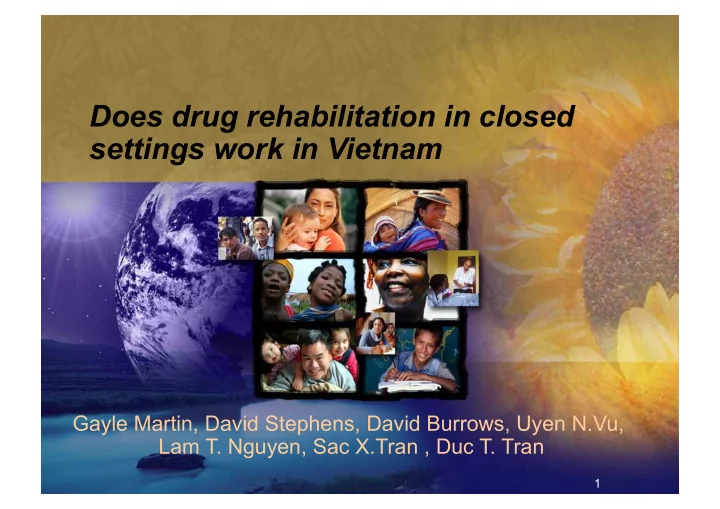

Does drug rehabilitation in closed settings work in Vietnam Gayle Martin, David Stephens, David Burrows, Uyen N.Vu, Lam T. Nguyen, Sac X.Tran , Duc T. Tran 1
Overview of presentation • Review of the policy environment regulating rehabilitation centers • Estimating the cost of the Institution-based response (rehabilitation centers) to drug related harm in Viet Nam • Conclusions 2
Overview of GOVN policies on drug rehabilitation in Viet Nam • Encouraging voluntary drug rehabilitation Encouraging voluntary drug rehabilitation • Compulsory rehabilitation in closed settings up to 2 years for those Compulsory rehabilitation in closed settings up to 2 years for those who relapsed or refuse to voluntary rehabilitation who relapsed or refuse to voluntary rehabilitation • 5 steps in drug rehabilitation (detoxification, behavior education, 5 steps in drug rehabilitation (detoxification, behavior education, labor therapy, drug relapse counseling and vocational training, post labor therapy, drug relapse counseling and vocational training, post rehabilitation management at community level) rehabilitation management at community level) • No harm reductions interventions in closed settings No harm reductions interventions in closed settings BUT BACKBONE OF DRUG REHABILITATION BUT BACKBONE OF DRUG REHABILITATION SYSTEM IN VIETNAM IS REHABILITATION IN SYSTEM IN VIETNAM IS REHABILITATION IN CLOSED SETTINGS (06 CENTERS ) CLOSED SETTINGS (06 CENTERS ) 3
Health policies on HIV/AIDS in closed settings • Only general medicines are provided; with current minimum subsidy of VND 250,000/trainee/entry • ART is not available in the most of 06 centers • Average HIV rate in 6 centers of the study is between 30 to 65% • HIV testing for trainees is not yet compulsory, but also not voluntary • Lack of VCT in the most of centers • Lack of understanding on drug dependence and drug relapse among o6 centers staff. • Only general IEC on HIV is available and it seems not effective 4
Methodology Estimate the unit cost of running a Rehabilitation Centre (cost per trainee per year) for centres in rural and urban settings • Project the number of IDUs in centres in future • Project discounted future cost implications 5
COST ANALYSIS 6
7
Unit costs 8
Survey of health records 9
Health costs: • Current level of health services provided is determined by revenues available at particular centre rather than health needs; • Actual health needs are growing rapidly with HIV rate at the centers • While supply costs per resident-day increase, health costs remain unchanged or even decline. This implies that allocation of resources for health care isn’t a priority. • Absence or unstable supply of drugs indicates that quality of health services is affected seriously by poor resource management and lack of attention on health care. 10
Health costs vs. Total costs 11
12
A summary of relapse rates in some provinces • Estimation based on experience: – For most provinces, the rate range is 70-95% (Review reports 2000-2005) – Only in one or two provinces the estimated relapse rate is 50-60% • Estimation based on research: – NIHE: 90% – A study in Thai Nguyen, with 1506 testing samples randomly selected from 11 locations during 4 years 2001-2004 shows relapse rate 94,8% 13
Rehabilitation in closed setting vs harm reduction VND USD Unit costs per resident in centers Rural 3,600,000 $225 Urban 10,200,000 $641 Unit cost of interventions VCT 1 350,000 $23.6 243,000-337,00 Needle & Syringe programs 0 $15-21 per clean needle 1,600 $0.10 4.665,000-9,400 Drug substitution treatment $292-$587 0.00 14 1 VCT includes ELISA test, distribution of condoms, IEC materials and consultancy
Final remarks • High HIV prevalence in most of centers • Services are not geared to drug dependence treatment and HIV treatment • Harm reduction is not allowed in closed settings yet • The Law on HIV/AIDS Prevention and Control (2006) promulgated harm reduction, but it is a legal conflict with Drug legislation • With current approach of putting drug users into 06 centers USD 146.9 millions will be required fro 2006-2015 • The relapse rate of drug use will be around 90% • Drug rehabilitation in closed settings is not cost-effective and does not work 15
Thank you Xin cam on 16
Recommend
More recommend